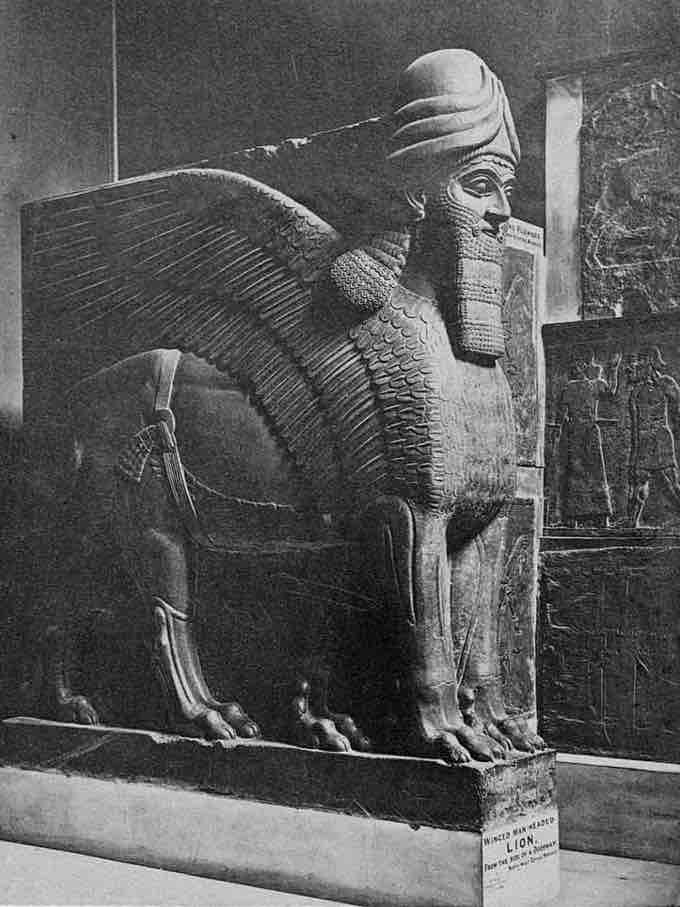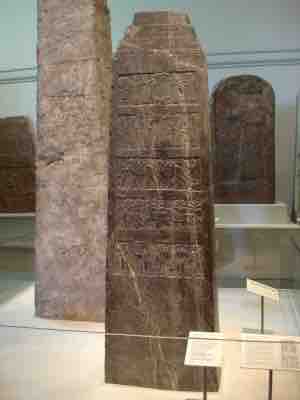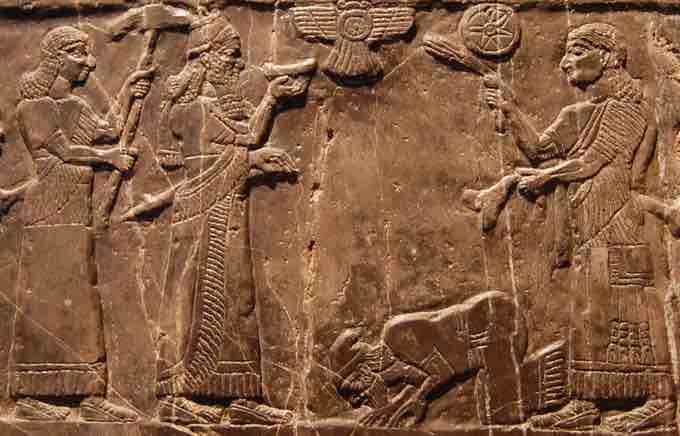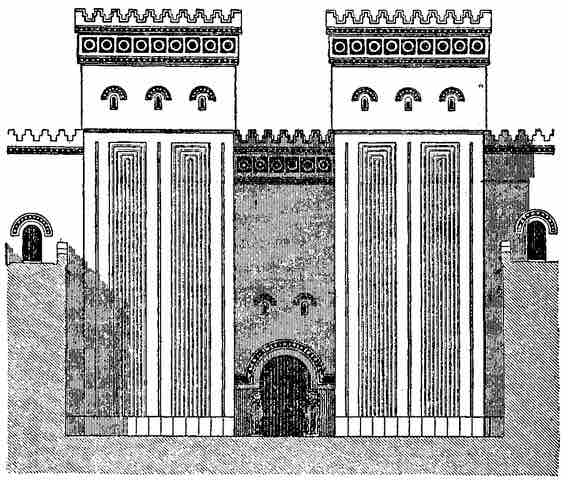Nimrud and Ashurnasirpal II
Nimrud is an ancient Assyrian city located in southern, modern Iraq on the River Tigris. In ancient times the city was called Kalhu. The ruins of the city are found some 30 kilometers (19 miles) southeast of Mosul.
The Assyrian king Shalmaneser I made Nimrud, which existed for about a thousand years, the capital in the thirteenth century BCE. The city gained fame when king Ashurnasirpal II of Assyria (c. 880 BCE) built a large palace and temples on the site of an earlier city that had long fallen into ruins. Nimrud housed as many as 100,000 inhabitants and contained botanic gardens and a zoologic garden. Ashurnasirpal's son, Shalmaneser III (858–824 BCE), built the monument known as the Great Ziggurat and an associated temple. The palace, restored as a site museum, is one of only two preserved Assyrian palaces in the world. The other is Sennacherib's palace at Nineveh. Nimrud remained the Assyrian capital until 706 BCE when Sargon II moved the capital to Dur-Sharrukin, but it remained a major center and a royal residence until the city was completely destroyed in 612 BCE when Assyria succumbed under the invasion of the Medes.
Excavations at Nimrud in the nineteenth and twentieth centuries revealed remarkable bas-reliefs, ivories, and sculptures. A statue of Ashurnasirpal II was found in an excellent state of preservation, as were colossal winged man-headed lions, each guarding the palace entrance. The large number of inscriptions pertaining to king Ashurnasirpal II provide more details about him and his reign than are known for any other ruler of this epoch.

Gate Guardians: The Man-Headed Lions
This Portal Guardian (Lamassu) from Nimrud guarded the entrance to the palace at Nimrud.
Portions of the site have been also been identified, such as temples to Ninurta and Enlil, a building assigned to Nabu (the god of writing and the arts), and extensive fortifications. Furthermore, the Black Obelisk of Shalmaneser III, discovered in 1846, stands six-and-a-half-feet tall and commemorates the king's victorious campaigns from 859–824 BCE. It is shaped like a temple tower at the top, ending in three steps.

Black Obelisk
The Black Obelisk of Shalmaneser III commemorates the king's victorious campaigns from 859–824 BCE.
On one panel, Israelites led by king Jehu of Israel pay tribute and bow in the dust before king Shalmaneser III, who is making a libation to his god. The cuneiform text on the obelisk reads "Jehu the son of Omri" and mentions gifts of gold, silver, lead, and spear shafts. The "Treasure of Nimrud" unearthed in these excavations is a collection of over 600 pieces of gold jewelry and precious stones.

Obelisk detail
Depiction of either Jehu son of Jehoshaphat son of Nimshi, or Jehu's ambassador, bowing before Shalmaneser III.
Sargon II and Dur-Sharrukin
Dur-Sharrukin, or present day Khorsabad, was the Assyrian capital in the time of King Sargon II. Today, Khorsabad is now a village in northern Iraq, and is still inhabited by Assyrians. The construction of Dur-Sharrukin was never finished. Sargon, who ordered the project, was killed during a battle in 705. After his death, his son and successor Sennacherib abandoned the project and relocated the capital with its administration to the city of Nineveh.

Palace of Khorsabad (artist's reconstruction)
Dur-Sharrukin was constructed on a rectangular layout. Its walls were massive, with 157 towers protecting its sides. Seven gates entered the city from all directions. A walled terrace contained temples and the royal palace. The main temples were dedicated to the gods Nabu, Shamash, and Sin, while Adad, Ningal, and Ninurta had smaller shrines. A ziggurat was also constructed at the site. The palace was adorned with sculptures and wall reliefs, with its gates flanked by winged-bull shedu statues weighing up to 40 tons. On the central canal of Sargon's garden stood a pillared pleasure-pavilion which looked up to a great topographic creation—a man-made Garden Mound. This mound was planted with cedars and cypresses and modeled after the Amanus mountains in northern Syria.
Winged bull
The winged bull figure, known as a shedu or a lamassu, was a common guardian figure in palace architecture.
The colossal bull statue (above) was uncovered outside the throne room. It was found split into three large fragments. The torso alone weighed about 20 tons. Since Dur-Sharrukin was a single-period site that was evacuated in an orderly manner after the death of Sargon II, few individual objects were found. The primary discoveries from Khorsabad shed light on Assyrian art and architecture.
Nineveh
Nineveh was an ancient Assyrian city on the eastern bank of the Tigris River, and the capital of the Neo-Assyrian Empire. Its ruins are across the river from the modern-day major city of Mosul in Iraq.
Today, Nineveh's location is marked by two large mounds, Kouyunjik and Nabī Yūnus "Prophet Jonah," and the remains of the city walls. These were fitted with fifteen monumental gateways which served as checkpoints on entering and exiting the ancient city, and were probably also used as barracks and armories. With the inner and outer doors shut, the gateways were virtual fortresses. Five of the gateways have been explored to some extent by archaeologists.
Nineveh was an important junction for commercial routes crossing the Tigris. Occupying a central position on the great highway between the Mediterranean Sea and the Indian Ocean, Nineveh united the East and the West, and received wealth from many sources. Thus, it became one of the oldest and greatest of all the region's ancient cities, and the capital of the Neo-Assyrian Empire. The area was settled as early as 6000 BCE, and by 3000 BCE had become an important religious center for worship of the Assyrian goddess Ishtar.
It was not until the Neo-Assyrian Empire that Nineveh experienced a considerable architectural expansion. King Sennacherib is credited with making Nineveh a truly magnificent city during his rule (c. 700 BCE). He laid out new streets and squares and built within it the famous "palace without a rival", the plan of which has been mostly recovered. It comprised at least 80 rooms, many of which were lined with sculpture. A large number of cuneiform tablets were found in the palace. The solid foundation was made out of limestone blocks and mud bricks. Some of the principal doorways were flanked by colossal stone-door figures that included many winged lions or bulls with the heads of men. The stone carvings in the walls include many battle and hunting scenes, as well as depicting Sennacherib's men parading the spoils of war before him.
Royal Nineveh carving
The king hunting lion from the North Palace, Nineveh, seen at the British Museum.
Nineveh's greatness was short-lived. In around 627 BCE, after the death of its last great king Ashurbanipal, the Neo-Assyrian empire began to unravel due to a series of bitter civil wars, and Assyria was attacked by the Babylonians and Medes. From about 616 BCE, in a coalition with the Scythians and Cimmerians, they besieged Nineveh, sacking the town in 612, and later razing it to the ground.
The Assyrian empire as such came to an end by 605 BC, with the Medes and Babylonians dividing its colonies between them. Following its defeat in 612, the site remained largely unoccupied for centuries with only a scattering of Assyrians living amid the ruins until the Sassanian period, although Assyrians continue to live in the surrounding area to this day.